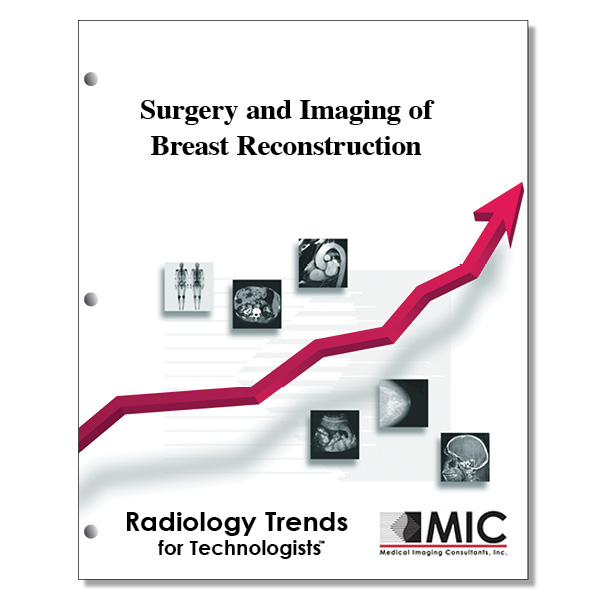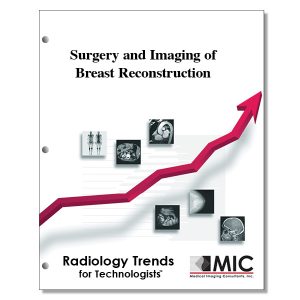

Surgery and Imaging of Breast Reconstruction
Following mastectomy, breast reconstruction methods and image appearance are reviewed.
Course ID: Q00383 Category: Radiology Trends for Technologists Modalities: Mammography, MRI, Sonography3.25 |
Satisfaction Guarantee |
$34.00
- Targeted CE
- Outline
- Objectives
Targeted CE per ARRT’s Discipline, Category, and Subcategory classification:
[Note: Discipline-specific Targeted CE credits may be less than the total Category A credits approved for this course.]
Breast Sonography: 3.25
Procedures: 3.25
Pathology: 1.00
Breast Interventions: 2.25
Mammography: 3.25
Patient Care: 1.00
Patient Interactions and Management: 1.00
Procedures: 2.25
Anatomy, Physiology, and Pathology: 2.25
Magnetic Resonance Imaging: 2.25
Procedures: 2.25
Body: 2.25
Registered Radiologist Assistant: 3.25
Patient Care: 1.00
Patient Management: 1.00
Procedures: 2.25
Thoracic Section: 2.25
Sonography: 2.25
Procedures: 2.25
Superficial Structures and Other Sonographic Procedures: 2.25
Radiation Therapy: 3.25
Patient Care: 2.25
Patient and Medical Record Management: 2.25
Procedures: 1.00
Treatments: 1.00
Outline
- Introduction
- Breast Reconstruction Techniques
- Reconstruction with Prosthetic Implants
- Reconstruction with Autologous Tissue Flaps
- Latissimus Dorsi Mycutaneous Flap
- TRAM Flaps
- Pedicled TRAM Flap
- Free TRAM Flap
- Free Muscle-sparing TRAM Flap
- DIEP Flap
- SIEA Flap
- Preoperative Imaging Studies
- Breast Imaging Appearances after Autologous Reconstruction
- Normal Finding and Benign Changes
- Seromas and Hematomas
- Fat Necrosis
- Fibrosis
- Breast Cancer Recurrence
- Normal Finding and Benign Changes
- Analysis of Patient Records at Our Breast Imaging Center
Objectives
Upon completion of this course, students will:
- discuss why breast reconstruction is performed following mastectomy
- describe the solutions utilized for prosthetic breast implants
- differentiate between silicon and saline breast implants
- explain the advantage of prosthetic breast reconstruction
- organize the grades of breast capsular contracture
- specify the preferred tissue donor site for autologous tissue flaps
- describe the advantage of the latissimus dorsi myocutaneous flap technique
- know what pedicled means
- describe how pedicled TRAM flaps are tunneled to the mastectomy site
- communicate the disadvantages of the pedicled TRAM flap procedure
- understand the advantages of the free TRAM flap technique
- list success factors for free TRAM flap procedures
- specify vessels used for free TRAM flap procedures
- identify components of the free muscle-sparing TRAM flap procedure
- describe components of the DIEP flap procedure
- list advantages of the DIEP flap procedure
- explain the use of the rectus abdominis muscle for SIEA flap procedures
- describe the veins utilized for SIEA flap procedures
- differentiate between pre-operative vascular mapping studies
- describe the appearance of reconstructed breasts on mammography and breast MRI
- list common benign changes in breasts reconstructed with autologous tissue flaps
- specify the time frame following radiation therapy when skin and trabeculae thickening of the reconstructed breast may occur
- explain the composition of seromas
- be familiar with the appearance of tissues on T2-weighted MR images
- describe factors causing seromas
- explain the cause of fat necrosis
- discuss the presentation of fat necrosis at physical examination
- describe the appearance of fibrosis on mammograms
- be familiar with the enhancement patterns of fibrosis and recurrent tumors following the injection of a gadolinimum-based MR contrast agent
- understand by how much breast cancer is reduced following mastectomy
- compare T1 and T2 tumor classifications
- describe where recurrent breast cancer occurs post-reconstruction
- list the factors influencing risk of local breast cancer recurrence
- be familiar with the features of MR subtraction imaging
- explain the relevance of additional imaging procedures when MR demonstrates abnormalities
